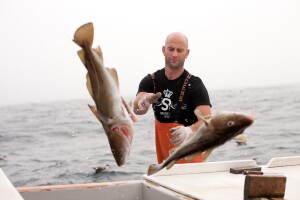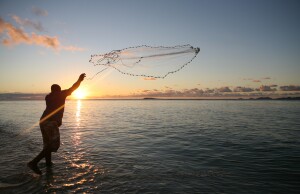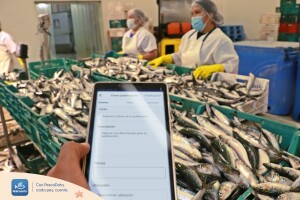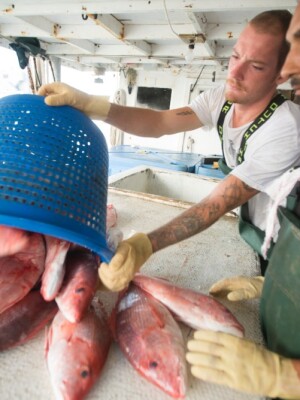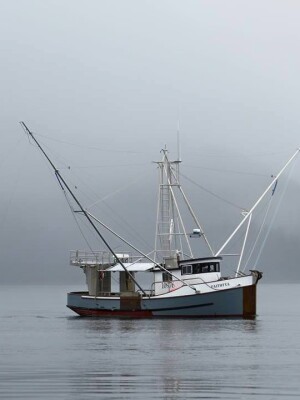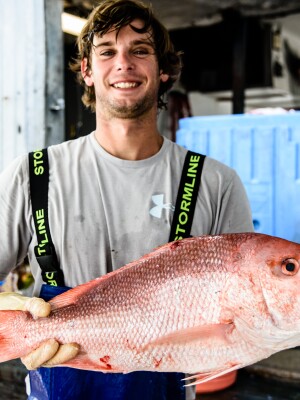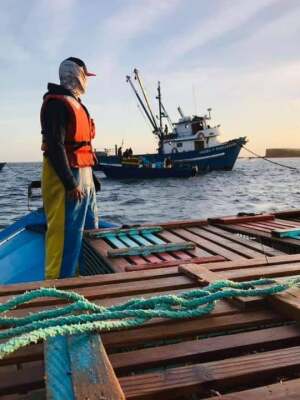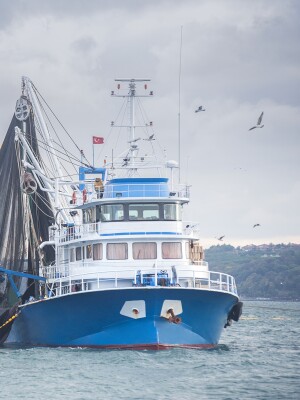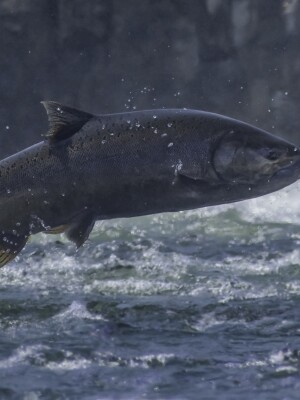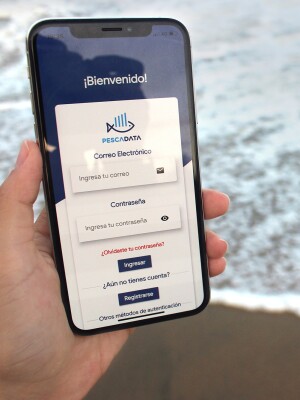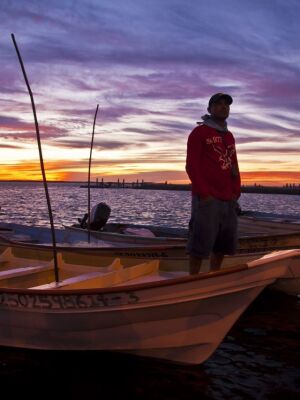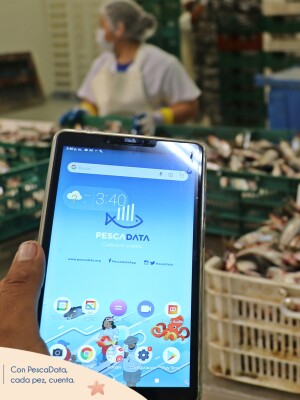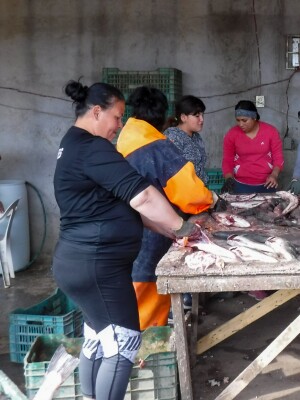From coast to coast, U.S. fishing communities rely on access to a steady supply of fish. But pricey fishing permits and quotas make it hard for small scale fishermen to compete. The high cost is a barrier to young fishermen. And lack of opportunities for the next generation puts the future of small-scale fishing at risk. It also impacts local supply chains and, in turn, local economies.
For decades, the Walton Family Foundation has worked to help oceans and people thrive. Yet, protecting marine fisheries remains a complex and evolving challenge.
To succeed, we must listen and learn from the fishing communities facing these challenges.
We must ask: How do we ensure that better fisheries management efforts will improve the economic status of fishing communities? This question led us to Catch Together, a project of Multiplier. Its innovative model creates social and economic benefits for fishermen and communities. It also protects the health of the fishery.
Catch shares manage how many fish each person can catch. This can shift the decision-making power and economic stability to the local level. Catch shares allocate fishermen a portion of the overall quota. This allows fishermen to catch fish more efficiently and/or at times that work for their business plan.
The approach has reduced overfishing, improved safety at sea and generated strong economic and social returns for quota owners. However, catch shares have been criticized by some. Fishermen just starting out say the quota or allocation assigned by the catch share program are hard to come by and cost too much.
Catch Together partners with commercial fishermen to make impact investments that address these barriers. It currently works with fishing communities in Alaska, Maine, Massachusetts and the Gulf of Mexico. Together, they secure access to quota and promote community-driven solutions.
The model ties together the economic value and long-term health of the fishery. It also creates funds to support local leadership and ongoing management improvements. Additionally, Catch Together keeps the economic benefits from the quota in the community. It also improves access for new entrants to the field. This includes underrepresented communities, women and young fishermen.
In 2018, Catch Together partnered with the Gulf of Mexico Reef Fish Shareholders’ Alliance to secure access to red snapper quota. This allowed conservation-minded small-scale commercial fishermen to reduce wasteful bycatch and discards. It also helped the next generation of commercial fishermen build stable businesses.
More than 20 fishermen from upwards of 10 Gulf Coast communities participate in this program annually. They attend fisheries management meetings and report their catch electronically. They also formed a steering committee aimed at growing the program to meet changing economic, ecosystem and community conditions.
This work is not easy. We know there is no silver bullet solution. But with an inclusive and collaborative process, we can protect and restore fisheries in sustainable ways. And we can promote the long-term economic stability of fishing communities and the local families who depend on them.
Dungeness crabs caught off the coast of California and the Pacific Northwest are steeped in many local cultural traditions. The Dungeness fishery is worth between $30-$90 million annually. It is central to the livelihoods of many Californians. This includes everyone from the fishermen who catch them to the retailers and restaurants that sell them
In recent years, impacts from climate change have seriously altered the availability of Dungeness crabs. In 2015, the opening of California’s Dungeness fishery was delayed for four months. The delay was due to a devastating algae bloom. This led to the proliferation of a dangerous neurotoxin (domoic acid) that makes crabs unsafe to eat.
In addition to facilitating harmful algal blooms, warming ocean temperatures have also led humpback whales to alter their feeding behavior. The change has moved them into crab fishing areas where they become entangled in fishing gear. In order to reduce entanglements, the Dungeness crab season has been regularly shortened. That has caused financial challenges for many small-scale fishermen.
Shortened fishing seasons are just one example of the impact climate change is having on West Coast fisheries. In April of 2023, both commercial and recreational Chinook salmon fishing in California and much of Oregon closed for the year. The closure was in anticipation of an expected near-record-low number of fish returning to the state’s rivers to spawn. This was due in large part to California’s extreme drought and in stream water management.
Climate change is expected to increase the frequency and severity of these unanticipated events and their severe economic impacts on fishing communities.
“To respond to these unprecedented conditions, we need to explore innovative strategies. Our goal is to prioritize both the health of our oceans and the livelihoods of fishermen,” says Cara Eisel, an Environment Program officer at the Walton Family Foundation. “That means convening diverse partners to work on shared solutions that benefit everyone.”
Fishery managers can respond to closures by declaring a fishery disaster. That then triggers a process for financial relief for fishermen and their communities. But fishermen are often left waiting years for promised relief to reach them. This has led to a growing interest among communities, stakeholders and state fisheries managers to explore ways to help fishermen adapt to closures.
That is why the Walton Family Foundation is supporting California Ocean Science Trust. UC Davis professors Dr. James Sanchirico and Dr. Matt Reimer are collaborating on a multi-year project to explore innovative, “climate-ready” strategies. The work is designed to help fisheries and fishing communities respond and adapt to disasters that impact them.
“Traditionally fishermen have a permit to fish a certain species in a certain space over a certain amount of time,” said Dr. Sanchirico. “This system has been largely successful from a conservation perspective. It’s helped manage overfishing so there will continue to be fish to catch in the future. But it was created in a time when ocean conditions were relatively stable. Climate change has made oceanic conditions much more volatile. That can drastically impact fishermen’s ability to make a living.
“If the species you have a permit to catch has moved due to warming temperatures or the fishery is shut down, fishermen have few options. One of this project’s goals is to help understand how we can create systems that can adapt to support both the fishermen and the health of the ecosystem.”
The team is working with the National Oceanic and Atmospheric Administration (NOAA) and stakeholders in fishing communities. The project evaluates different regulatory and permitting program design options. The goal is to help fishermen weather shutdowns.
By putting science to work ... we can find ways to ensure that fishing communities can maintain their livelihoods.
Examples of climate-ready adaptations could include enabling fishermen access to catch other species. It could also change the type of fishing gear they are using, or fish in a different area.
“Those closest to the problem are often closest to the solution,” said Eisel. “That is why the team is working with fishermen on the ground to get insight into what adaptations would be useful. They can also help identify any unintended consequences different solutions might trigger.”
“Having these adaptability options researched and in place ahead of disasters can help managers navigate the big challenges ahead,” said Anthony Rogers, director of programs at California Ocean Science Trust. “By putting science to work and examining a wide range of possible solutions, we can find ways to ensure that fishing communities can maintain their livelihoods. And keep species like Dungeness crab and Chinook salmon healthy and sustainable. That will help ensure they are available now and for the next generation.”
In many areas of Mexico, the government creates fishing refuges, known as refugia. These are areas designed to conserve marine habitats and fisheries resources. Local fishing communities make decisions about when and where fishing is allowed to help fish populations recover in the refugia.
Comunidad y Biodiversidad (COBI), a Walton Family Foundation grantee, helps local fishers design and implement programs to track progress in their fishing refugia.
“The local fishers enjoy seeing the results and sharing what is working with their communities,” said Maria Jose Espinosa-Romero, COBI's chief executive officer.
To support these monitoring efforts, COBI created PescaData. It is an app that fishers can use to report their catch data. This data is used to inform overall fishery management. The COBI team realized that the fishers using the app were constantly adapting to challenges in the marine environment. The app could become a forum for the fishers to share knowledge, experiences and local solutions with each other.
We knew we needed to find ways to make technology accessible for all communities.
“We kept hearing stories about fishing communities helping each other find solutions to common challenges. For example, one fishing community was dealing with lobsters that weren’t molting. They were able to connect with another fishing village. That village had figured out that the late molting period in their area was due to the large amounts of rain. They voluntarily closed their fishery for a few weeks until the lobsters were ready to harvest,” said Stuart Fulton, COBI's director of change.
“Another set of communities shared what they were doing to bring back clams to the in-shore area in the region. We knew we needed to find ways to make technology accessible for all communities. This way they could learn from their peers’ experiences.”
The PescaData app has over 2,300 users. It also has 170 examples of solutions being used by fishers in Mexico. Moving forward, COBI would like to expand the use of the app to all Latin America. This will help more fishers share information about how to deal with the growing impacts of climate change.
“COBI had a vision for how this app could grow in scope. This is a perfect example of how we need to keep fostering innovation and new ideas to help us address evolving challenges in ways that work for nature and people,” said Daylin Muñoz Nuñez, an Environment program officer with the foundation’s Oceans Initiative.

